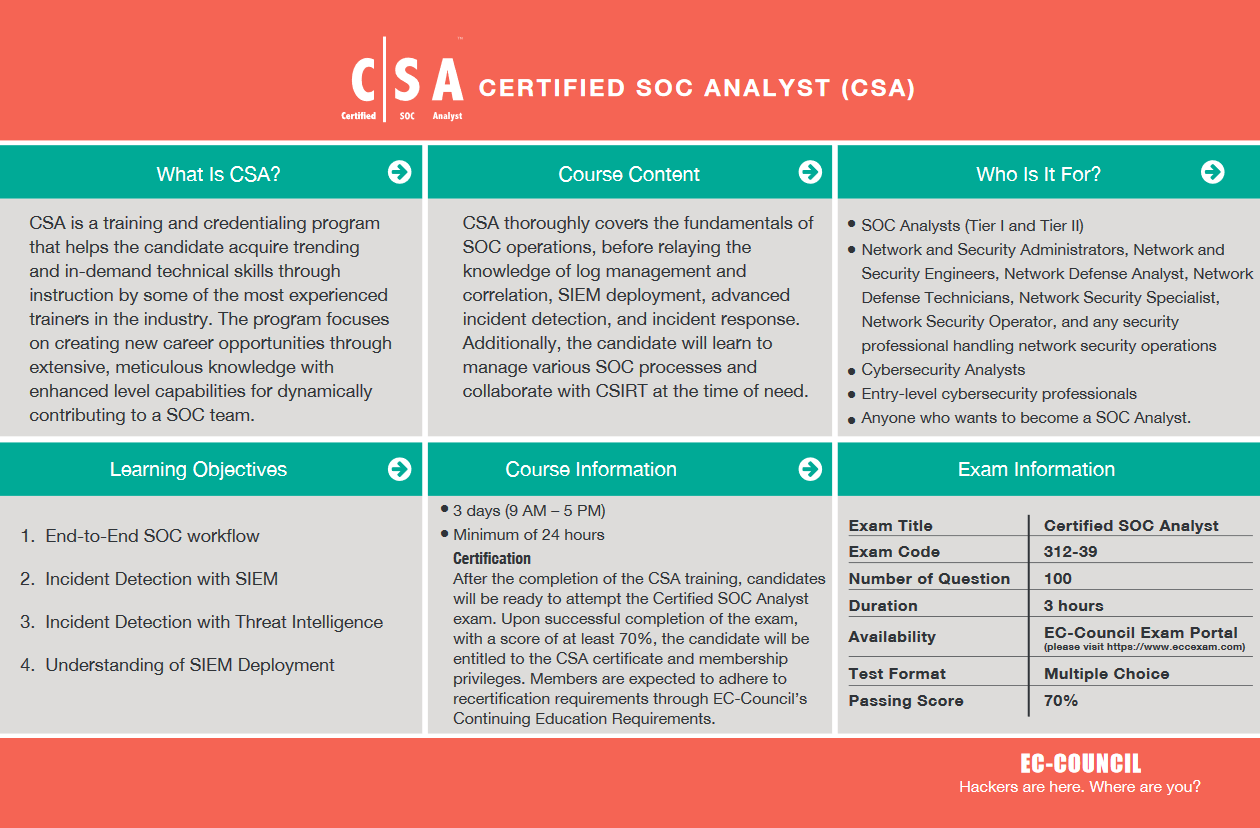CERTIFIED SOC ANALYST (CSA)

Course Description
The Certified SOC Analyst (CSA) program is the first step to joining a security operations center (SOC). It is engineered for current and aspiring Tier I and Tier II SOC analysts to achieve proficiency in performing entry-level and intermediate-level operations.
CSA is a training and credentialing program that helps the candidate acquire trending and in-demand technical skills through instruction by some of the most experienced trainers in the industry. The program focuses on creating new career opportunities through extensive, meticulous knowledge with enhanced level capabilities for dynamically contributing to a SOC team. Being an intense 3-day program, it thoroughly covers the fundamentals of SOC operations, before relaying the knowledge of log management and correlation, SIEM deployment, advanced incident detection, and incident response. Additionally, the candidate will learn to manage various SOC processes and collaborate with CSIRT at the time of need.

NASCIO Representing Chief Information Office of the States revealed in over a year-long survey (July 2016 – December 2017), “since the creation of the SOC, the security division has seen an overall 64 percent decrease in incident response time.”

As the security landscape is expanding, a SOC team offers high quality IT-security services to actively detect potential cyber threats/attacks and quickly respond to security incidents. Organizations need skilled SOC Analysts who can serve as the front-line defenders, warning other professionals of emerging and present cyber threats.
The lab-intensive CSA program emphasizes the holistic approach to deliver elementary as well as advanced knowledge of how to identify and validate intrusion attempts. Through this, the candidate will learn to use SIEM solutions and predictive capabilities using threat intelligence. The program also introduces the practical aspect of SIEM using advanced and the most frequently used tools. The candidate will learn to perform enhanced threat detection using the predictive capabilities of Threat Intelligence.
Recent years have witnessed the evolution of cyber risks, creating an unsafe environment for the players of various sectors.
To handle these sophisticated threats, enterprises need advanced cybersecurity solutions along with traditional methods of defense. Practicing good cybersecurity hygiene and implementing an appropriate line of defense, and incorporating a security operations center (SOC) have become reasonable solutions. The team pursues twenty-four-hour and “follow-the-sun” coverage for performing security monitoring, security incident management, vulnerability management, security device management, and network flow monitoring.
A SOC Analyst continuously monitors and detects potential threats, triages the alerts, and appropriatley escalates them. Without a SOC analyst, processes such as monitoring, detection, analysis, and triaging will lose their effectiveness, ultimately negatively affecting the organization.
Target Audience
- SOC Analysts (Tier I and Tier II)
- Network and Security Administrators, Network and Security Engineers, Network Defense Analyst, Network Defense Technicians, Network Security Specialist, Network Security Operator, and any security professional handling network security operations
- Cybersecurity Analyst
- Entry-level cybersecurity professionals
- Anyone who wants to become a SOC Analyst.
Suggested Duration
- 3 days (9 am – 5 pm)
- Minimum of 24 hours
Certification
After the completion of the CSA training, candidates will be ready to attempt the Certified SOC Analyst exam. Upon successful completion of the exam, with a score of at least 70%, the candidate will be entitled to the CSA certificate and membership privileges. Members are expected to adhere to recertification requirements through EC-Council’s Continuing Education Requirements.
Exam Details
The CSA exam is designed to test and validate a candidate’s comprehensive understanding of the jobs tasks required as a SOC analyst. Thereby validating their comprehensive understanding of a complete SOC workflow.
| Exam Title | Certified SOC Analyst |
|---|---|
| Exam Code | 312-39 |
| Number of Questions | 100 |
| Duration | 3 hours |
| Availability | EC-Council Exam Portal (please visit https://www.eccexam.com) |
| Test Format | Multiple Choice |
| Passing Score | 70% |
Exam Eligibility Requirement
The CSA program requires a candidate to have one year of work experience in the Network Admin/Security domain and should be able to provide proof of the same as validated through the application process unless the candidate attends official training.
Course Outline
Module 01 Security Operations and Management
Module 02 Understanding Cyber Threats, IoCs, and Attack Methodology
Module 03 Incidents, Events, and Logging
Module 04 Incident Detection with Security Information and Event Management (SIEM)
Module 05 Enhanced Incident Detection with Threat Intelligence
Module 06 Incident Response
8 Critical Components of CSA
CSA maps 100 percent to the National Initiative for Cybersecurity Education (NICE) framework under the “Protect and Defend (PR)” category for the role of Cyber Defense Analysis (CDA). It is designed as per the real-time job roles and responsibilities of a SOC analyst.
The CSA course trains the candidate to use various defensive measures and data collected from multiple sources to identify, analyze, and report events that might occur or are already present in the network to protect data, systems, and networks from threats.
CSA offers an insightful understanding of end-to-end SOC overflow. It includes all SOC procedures, technologies, and processes to collect, triage, report, respond, and document the incident.
Training on various use cases of SIEM (Security Information and Event Management) solutions to detect incidents through signature and anomaly-based detection technologies. Candidates will learn incident detection on different levels – Application level, Insider level, Network level, and Host level.
CSA covers a module dedicated to rapid incident detection with Threat Intelligence. The module also imparts knowledge on integrating Threat Intelligence feeds into SIEM for enhanced threat detection.
It covers 45 elaborated use cases which are widely used across all the SIEM deployments.
CSA being a practically-driven program, offers hands-on experience on incident monitoring, detection, triaging, and analysis. It also covers containment, eradication, recovery, and reporting of the security incidents. To that end, there are 80 tools incorporated into the training.
There are 22 labs in total in the CSA program, which demonstrates processes aligned to the SOC Workflow. These include, but are not restricted to, activites such as:
The CSA program comes with additional reference material, including a list of 291 common and specific use cases for ArcSight, Qradar, LogRhythm, and Splunk’s SIEM deployments.
Learning Objectives of CSA
- Gain Knowledge of SOC processes, procedures, technologies, and workflows.
- Gain basic understanding and in-depth knowledge of security threats, attacks, vulnerabilities, attacker’s behaviors, cyber kill chain, etc.
- Able to recognize attacker tools, tactics, and procedures to identify indicators of compromise (IOCs) that can be utilized during active and future investigations.
- Able to monitor and analyze logs and alerts from a variety of different technologies across multiple platforms (IDS/IPS, end-point protection, servers and workstations).
- Gain knowledge of Centralized Log Management (CLM) process.
- Able to perform Security events and log collection, monitoring, and analysis.
- Gain experience and extensive knowledge of Security Information and Event Management.
- Gain knowledge on administering SIEM solutions (Splunk/AlienVault/OSSIM/ELK).
- Understand the architecture, implementation and fine tuning of SIEM solutions (Splunk/AlienVault/OSSIM/ELK).
- Gain hands-on experience on SIEM use case development process.
- Able to develop threat cases (correlation rules), create reports, etc.
- Learn use cases that are widely used across the SIEM deployment.
- Plan, organize, and perform threat monitoring and analysis in the enterprise.
- Able to monitor emerging threat patterns and perform security threat analysis.
- Gain hands-on experience in alert triaging process.
- Able to escalate incidents to appropriate teams for additional assistance.
- Able to use a Service Desk ticketing system.
- Able to prepare briefings and reports of analysis methodology and results.
- Gain knowledge of integrating threat intelligence into SIEM for enhanced incident detection and response.
- Able to make use of varied, disparate, constantly changing threat information.
- Gain knowledge of Incident Response Process.
- Gain understating of SOC and IRT collaboration for better incident response.
Testimonials




With this kind of growth in the market, it is inevitable that there is a strong demand for TI professionals.
Take a look at the current jobs listed on leading job portals on cyber threat intelligence related job roles:





